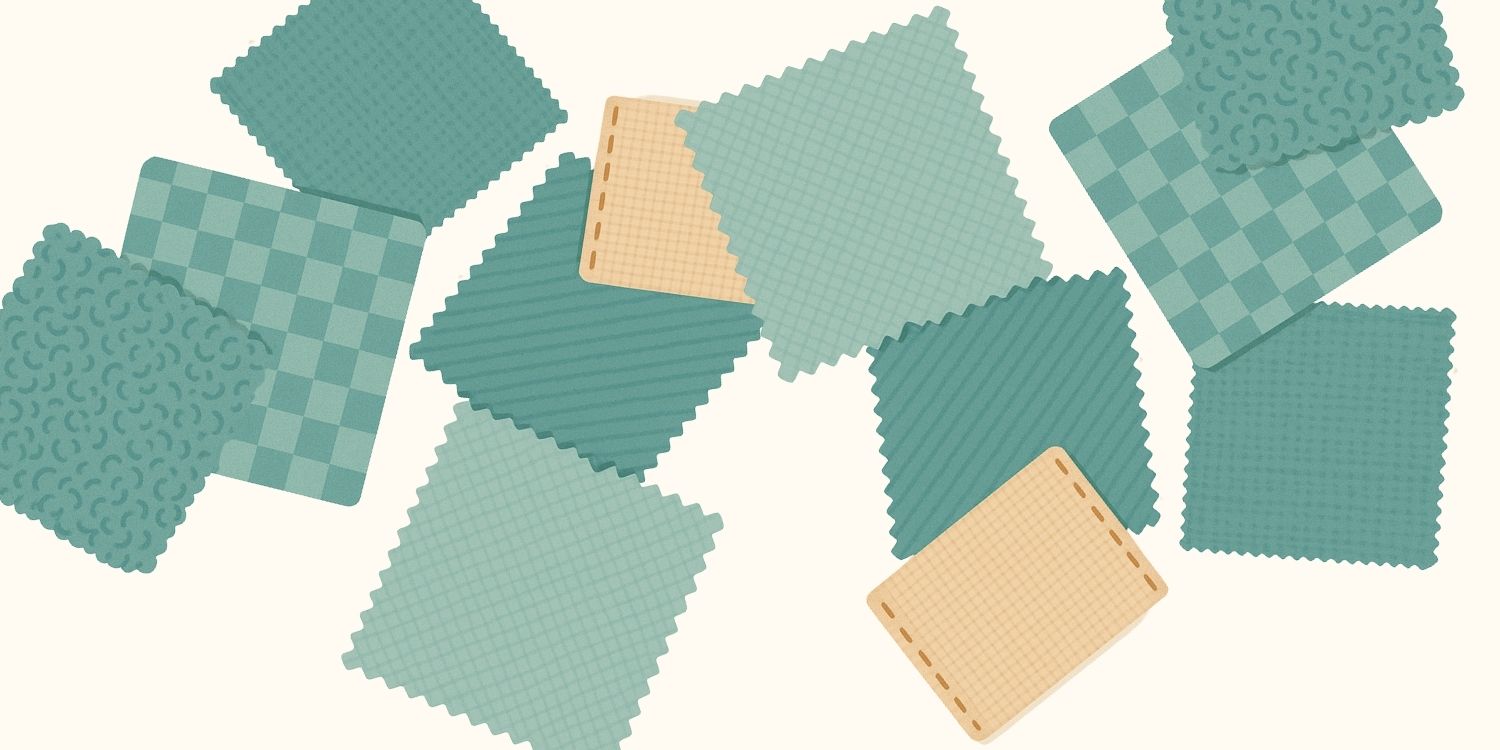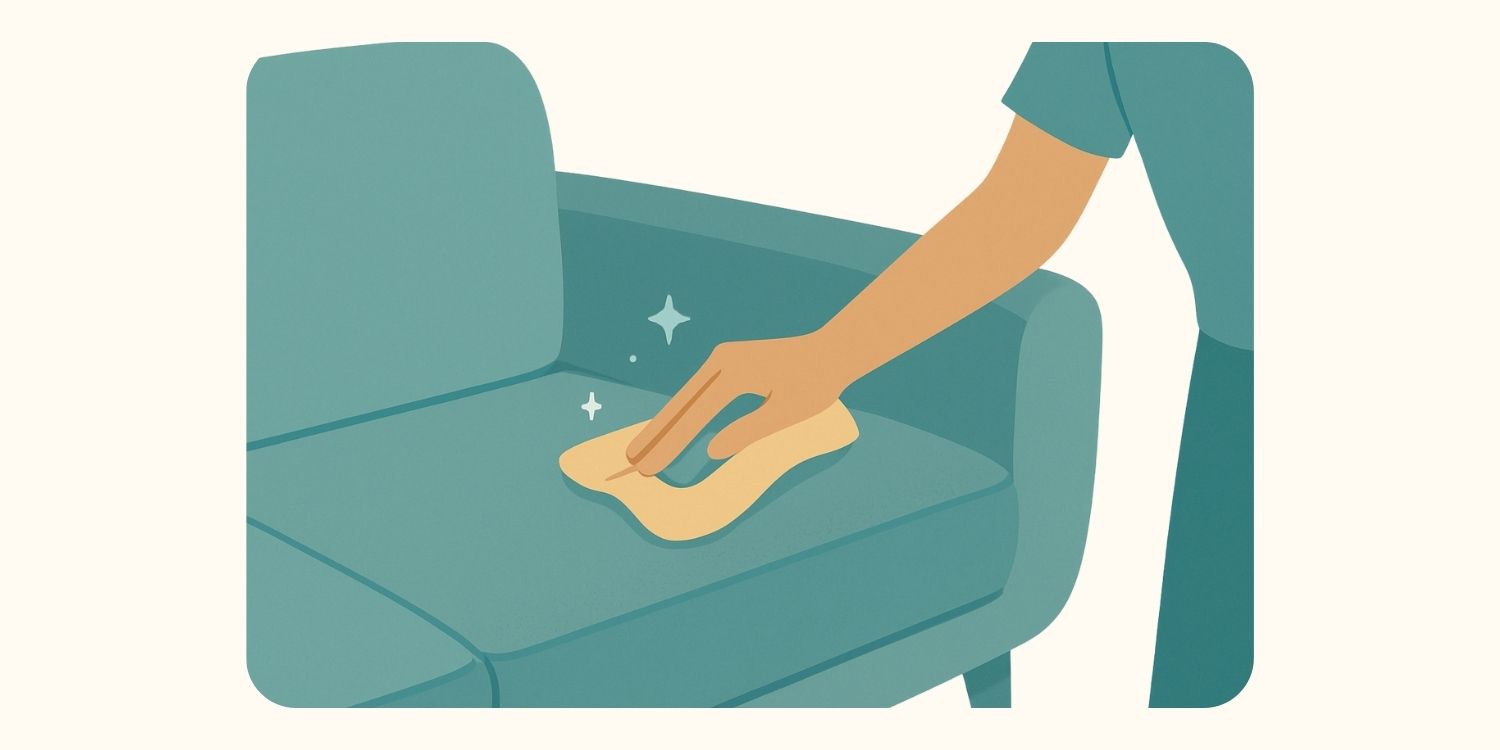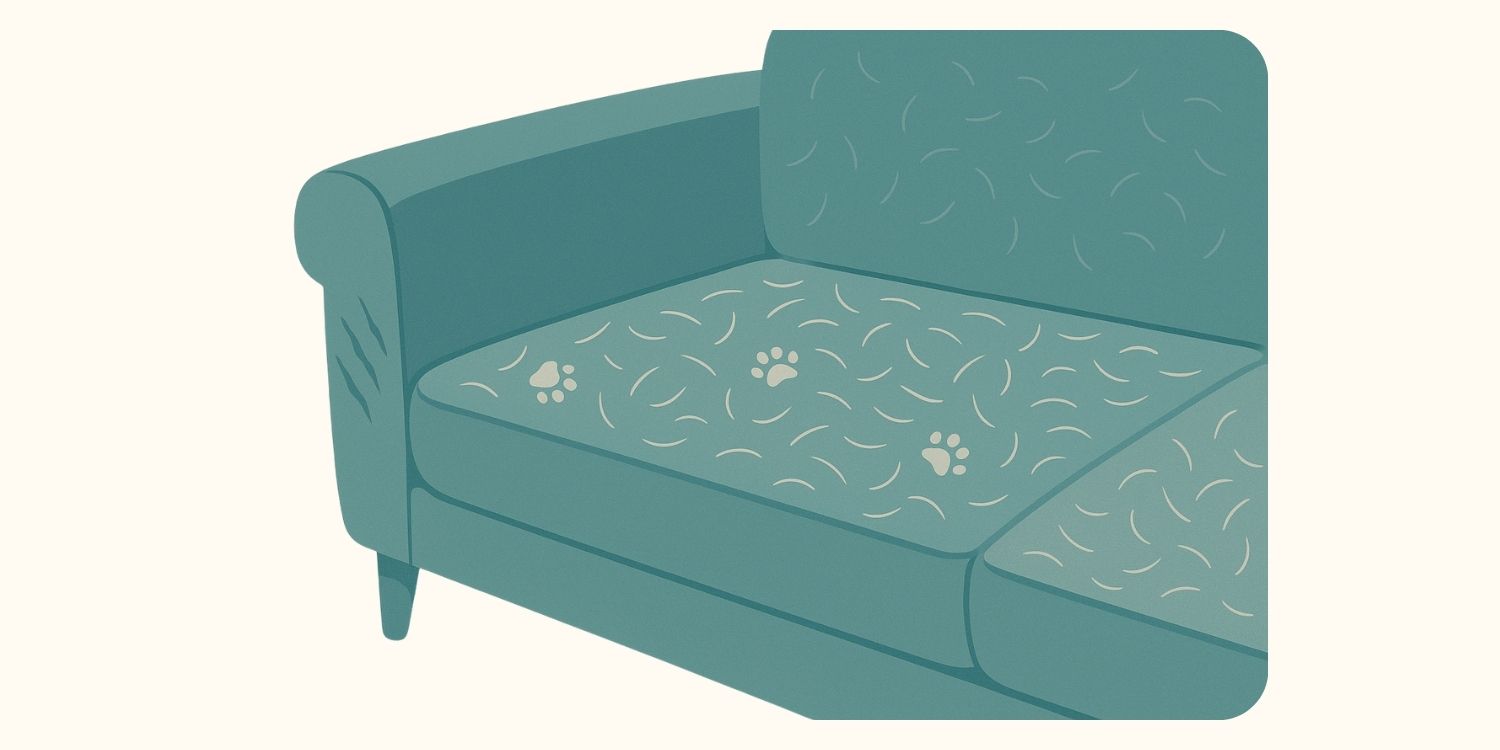by Eric Hod | Design Manager, Hudson’s Furniture
How to Choose Upholstery That Fits Your Life
Your sofa is likely the most-used piece of furniture in your home, and the fabric you choose determines how well it holds up to daily life. The right upholstery resists stains, cleans easily, and still looks fresh years after purchase. The wrong choice leads to faded colors, embedded pet hair, and permanent reminders of every spill.
The challenge is that fabric performance isn’t obvious from appearance alone. A beautiful linen might wrinkle and stain within months, while a synthetic blend that looks similar could serve your family for a decade. Understanding how different materials actually perform, not just how they look in the showroom, separates a sofa you love from one you regret.
This guide walks you through everything you need to know about sofa fabrics, from the practical performance of microfiber to the timeless elegance of leather. You’ll learn which materials stand up to pets and children, which ones offer the easiest maintenance, and how to balance durability with the look and feel you want in your home.
Jump to what you want to know:
- Understanding fabric durability testing methods
- Sofa fabric comparison chart
- Which sofa fabric is best for pets?
- Sofa fabrics to avoid if you own pets
- Which sofa fabric is best for kids?
- What is performance fabric & are they worth the money?
- Is a velvet sofa a good sofa fabric option?
- How to choose sofa fabric based on room use
- Frequently Asked Questions
How to Evaluate Sofa Fabric Durability & Performance
Before diving into specific fabric types, it helps to understand the characteristics that determine whether a material will work well in your home. The best fabric for your neighbor’s formal living room might be completely wrong for your busy family room. Here’s what actually matters when evaluating upholstery options.
Understanding Durability Testing Methods
Fabric durability is measured through abrasion tests that simulate the wear occurring when someone sits down and stands up repeatedly. Two primary testing methods exist, and understanding both matters because furniture manufactured in different regions uses different standards.
The Wyzenbeek test, standard in North America, rubs cotton duck fabric or wire mesh back and forth in straight lines across the test material. Each back-and-forth motion counts as one “double rub,” and the test continues until two yarns break or significant wear appears. The Martindale test, used in Europe and internationally, rubs discs of worsted wool or sandpaper against the fabric in a figure-eight motion, measuring results in “rubs” or “cycles.”
These tests aren’t directly interchangeable, so pay attention to which standard applies when comparing fabrics.
Understanding Fabric Performance
Durability tells you how long a fabric will last under physical wear, but it’s only one component of overall performance. Performance encompasses everything that determines how a fabric behaves in real-world conditions: stain resistance, fade resistance, moisture repellency, ease of cleaning, and resistance to pilling and snagging.
A fabric can score well on durability tests but still perform poorly in a family home. Cotton, for example, holds up reasonably well to abrasion but absorbs stains quickly and requires significant effort to clean. Conversely, some performance-treated fabrics resist staining so effectively that spills bead up on the surface even though their raw durability rating is only moderate.
When evaluating upholstery options, consider both metrics:
- Durability answers: How long will this fabric last before showing physical wear?
- Performance answers: How well will this fabric resist stains, fading, and damage while remaining easy to maintain?
The ideal fabric for your home depends on which factors matter most to your lifestyle. The comparison chart below rates common upholstery materials across both durability and key performance characteristics, helping you identify which fabrics align with your household’s specific needs.
Sofa Fabric Comparison Guide
How common upholstery fabrics perform across key factors
| Fabric | Stain Resistance | Fade Resistance | Moisture | Cleaning | Pilling | Best For |
|---|---|---|---|---|---|---|
| Light Duty (<9K Wyzenbeek / <15K Martindale) | ||||||
| Silk | Stains permanently | Fades quickly | Water-spots | Pro only | Snags easily | Formal pieces |
| Medium Duty (9K–15K Wyzenbeek / 15K–25K Martindale) | ||||||
| Cotton | Absorbs quickly | Won’t fade | Absorbs | Pro for stains | May pill | Casual, slipcovers |
| Linen | Sets quickly | Fades over time | Absorbs | Pro cleaning | Resistant | Formal, adult spaces |
| Chenille | Absorbs in loops | May fade | Absorbs | Vacuum, spot | Snags easily | Comfort, no pets |
| Faux Leather | Wipes clean | Resists well | Fully repellent | Damp cloth | Won’t pill | Budget, easy care |
| Heavy Duty (15K–30K Wyzenbeek / 25K–30K Martindale) | ||||||
| Full-Grain Leather | Wipe quickly | Needs protection | Not resistant | Condition 2x/yr | Won’t pill | Investment, patina |
| Top-Grain Leather | Coated protection | Moderate | Repels well | Condition 2x/yr | Won’t pill | Family leather |
| Microfiber | Repels liquids | Good resistance | Beads up | Soap & water | Highly resistant | Budget families |
| Polyester Blend | Light stains | Excellent | Moderate | Vacuum weekly | Good | Everyday use |
| Performance Velvet | With treatment | Resists fading | Treated | Vacuum, steam | Resists snags | Style-focused |
| Wool | Natural resistance | Good natural | Natural | Vacuum, pro | May pill | Cool climates |
| Commercial Grade (30K+ Wyzenbeek / 30K–40K+ Martindale) | ||||||
| Performance Fabric | Beads & wipes | Solution-dyed | Fully repellent | Soap & water | Highly resistant | Families, pets |
Common Questions When Choosing Sofa Fabric for Your Lifestyle
Now that you understand how fabrics perform across different characteristics, the next step is matching those properties to your specific household. Most shoppers face similar questions when narrowing down their options: Will this hold up to my kids? Can my pets use this sofa without destroying it? Which fabrics work best in my particular rooms?
The answers depend less on finding the single “best” fabric and more on understanding which materials align with your daily reality. A family with three young children and two dogs needs different properties than empty nesters who entertain occasionally. The following sections address the most common lifestyle scenarios and recommend fabrics that genuinely work for each situation.

Which Sofa Fabric Is Best for Pets?
If you share your home with dogs or cats, your fabric choice becomes particularly important. Pets bring unique challenges: claws that can snag or puncture, fur that clings to textured fabrics, muddy paws, and occasional accidents. The right fabric makes living with pets easier while keeping your furniture looking great.
Top 3 Pet-Friendly Sofa Fabrics
1. Performance Fabrics (Crypton, Sunbrella, Revolution): Performance fabrics represent the gold standard for pet-friendly upholstery. These engineered materials are specifically designed to resist stains, repel moisture, and withstand heavy use while remaining soft and attractive. They’re treated to be antimicrobial, which helps prevent odors from pet accidents. While performance fabrics typically cost more than standard options, their durability often makes them more economical over the sofa’s lifetime.
2. Microfiber: Microfiber consistently ranks as one of the best options for pet owners. Its ultra-fine synthetic fibers create an exceptionally tight weave that resists pet claws and repels liquids before they can soak in. Pet hair tends to sit on the surface rather than embed in the fabric, making it easy to vacuum or brush away. Most microfiber can be cleaned with just mild soap and water, which simplifies maintenance considerably.
3. Leather (Top-Grain or Full-Grain): Leather offers excellent practicality for pet households. It doesn’t trap odors or pet hair, and messes wipe away easily. However, leather can scratch, particularly from cat claws or dogs with untrimmed nails. Many pet owners consider this acceptable because leather develops a beautiful patina over time, and minor scratches blend into this natural aging. If visible scratches concern you, look for distressed or heavily grained leather that disguises marks more effectively.
Sofa Fabrics to Avoid if You Own Pets
Some materials simply don’t hold up well to life with animals. Silk and other delicate natural fibers snag and stain too easily. Loosely woven fabrics like chenille and bouclé catch claws and trap fur deep in their texture. Traditional velvet (not performance velvet) shows every mark and requires frequent maintenance. If you love these fabrics but have pets, consider using them in rooms your animals don’t access, like formal living rooms or studies.

Which Sofa Fabric Is Best for Kids?
Families with children need sofas that can handle spills, sticky fingers, marker mishaps, and the general chaos of childhood. The goal is to find fabric that cleans easily without requiring constant vigilance or limiting how your family uses the living room.
Top Three Kid-Friendly Sofa Fabrics
1. Performance Fabrics: Performance fabrics excel in homes with children for the same reasons they work well with pets: exceptional stain resistance and easy cleaning. Many performance fabrics allow you to clean spills with just water and mild soap, and some can even be bleached for tougher stains. This makes them ideal for families who want to enjoy their furniture without constantly worrying about accidents.
2. Leather and Faux Leather: Leather and faux leather offer practical advantages for families. Spills wipe away before they can soak in, and the material doesn’t harbor crumbs or debris. Leather is particularly forgiving of the everyday wear children create, and it actually becomes more comfortable and attractive with age. For families concerned about the initial stiffness of new leather, know that it softens considerably with use.
3. Microfiber: Microfiber provides an excellent balance of durability, comfort, and affordability for family homes. It resists staining better than most natural fabrics, cleans easily, and feels soft enough for kids to enjoy. Its tight weave also makes it more resistant to punctures and tears than looser materials.
Special Considerations for Family Homes
Beyond fabric type, color, and pattern significantly impact how well your sofa holds up visually. Solid light colors show every stain, while solid dark colors reveal dust, lint, and pet hair. Interior designers recommend fabrics with multi-tone threads or subtle patterns because they camouflage minor stains and wear far better than solids. Consider mid-tones like taupe, sage, or slate rather than pure white or black.
Also consider your children’s ages and activities. Toddlers and young children create different messes than teenagers. Young children tend to spill drinks and food, while older kids might be harder on cushion construction from jumping or rough play. Tightly woven polyester blends offer good durability at accessible price points if you expect to replace the sofa as your family’s needs change.

What Is Performance Fabric?
Performance fabric is an upholstery textile engineered to resist stains, repel liquids, and withstand heavy use while still feeling soft and looking beautiful. Unlike traditional fabrics that absorb spills and trap odors, performance fabrics are treated or woven with technologies that cause liquids to bead on the surface, making cleanup as simple as wiping with a damp cloth. Most performance fabrics also resist fading, pilling, and microbial growth, so they maintain their appearance far longer than conventional upholstery.
These engineered textiles first emerged in the 1990s to solve problems in commercial settings. Hotels, hospitals, and restaurants needed upholstery that could handle constant use without looking worn within months. The solution worked so well that homeowners quickly took notice. Families with kids and pets, hosts who entertain frequently, and anyone tired of treating furniture like museum pieces discovered that performance fabrics let them actually live on their sofas. Today, performance fabrics represent one of the fastest-growing segments in residential upholstery, with major furniture brands offering them as standard options rather than specialty upgrades.
Are Performance Fabrics Worth the Money?
Because of performance fabrics’ longevity and durability, sofas crafted from this material are often more expensive than their traditional fabric or leather counterparts. This leaves many homeowners asking if the benefits are worth the financial investment. To answer this critical question, homeowners should consider the rooms in which performance-fabric-covered furniture will live.
In high-traffic areas, family rooms where kids pile in after school, pets make themselves at home, and guests gather regularly, the added protection and easy maintenance typically justify the higher price. The fabric’s ability to resist stains, repel spills, and maintain its appearance over years of daily use can significantly reduce professional cleaning costs and delay the need for replacement.
However, in low-use spaces such as guest rooms or formal sitting areas, the advantages may never be fully realized. If a sofa is rarely used, the extra durability becomes more of a safety net than a necessity, and traditional upholstery may offer better value without sacrificing comfort or style.
Most homeowners find that the most cost-effective approach is a thoughtful mix: invest in performance fabric where daily life puts furniture to the test, and choose standard upholstery where wear and tear remain minimal.

Is a Velvet Sofa a Good Sofa Fabric Option?
Velvet’s luxurious appearance makes it perennially popular, but many people worry it’s too delicate for real life. The truth is more nuanced than you might expect. Modern velvet options vary widely in durability, and the right type can work beautifully even in active households.
Understanding Different Kinds of Velvet
Not all velvet is created equal, and knowing the differences helps you choose wisely. Performance velvet, usually polyester-based, offers the plush look of traditional velvet with significantly better durability. It resists crushing, fading, and staining far better than natural alternatives, and manufacturers often treat it with stain-repellent finishes. Performance velvet typically rates at 40,000+ double rubs, making it suitable for family furniture that sees daily use.
Cotton velvet provides the richest, most luxurious texture, but crushes and stains more easily. It’s best reserved for low-traffic pieces or formal spaces where it won’t face constant wear. Mohair velvet is extremely durable and naturally stain-resistant, but it comes at a premium price that puts it out of reach for many budgets.
Why Velvet is a Surprisingly Practical Sofa Fabric
Contrary to popular belief, velvet has several practical benefits that make it friendlier to everyday life than its reputation suggests. Its flat pile, unlike looped fabrics, is difficult to snag. This actually makes velvet more forgiving of pet claws than materials like chenille. Pet hair sits on the surface rather than embedding into the weave, so it vacuums away easily during routine cleaning. The fabric’s density also provides good durability when you choose performance versions designed for heavy use.
Velvet’s visual appeal is undeniable. Its pile catches light beautifully, creating depth and richness that flat fabrics simply can’t match. This quality makes it an excellent choice for creating a sophisticated focal point in your living room without sacrificing function for style.
Things to Consider Before Buying a Velvet Sofa
Velvet does require more maintenance than some alternatives, and it’s worth being honest with yourself about whether you’ll provide it. The pile can develop pressure marks or “crushing” in high-use areas, though these usually brush out or respond to steaming. Spills need immediate attention to prevent staining from setting in. The fabric also shows dust and lint more readily than some options, requiring regular vacuuming to keep it looking its best.
For busy households with kids and pets, performance velvet offers a good compromise between luxury and livability. For formal or adult-only spaces, even natural velvet can work beautifully with proper care. The key is being realistic about the maintenance involved and choosing a velvet type that matches how you actually live rather than how you hope to live.
How to Choose Sofa Fabric Based on Room Use
The same household often needs different fabrics in different rooms. A formal living room has different demands than a family room, and a bedroom sitting area differs from both. Matching fabric to intended use ensures each piece performs well in its specific context.
Fabric Selection by Room Type
Match your fabric choice to each room’s use and traffic level
| Room | Traffic | Best Fabrics | Colors/Patterns | Key Considerations |
|---|---|---|---|---|
| Family Room | Heavy daily | Performance fabrics, microfiber, leather, tight polyester | Mid-tones, subtle patterns; avoid solid white/black | Prioritize stain resistance; plan for food, drinks, pets |
| Formal Living | Light, occasional | Linen, cotton velvet, silk blends, wool | Lighter colors OK; elegant solids work | Focus on aesthetics; delicate fabrics work with minimal wear |
| Bedroom | Light to moderate | Chenille, plush velvet, soft cotton, performance velvet | Personal preference; skin comfort matters | Prioritize soft texture and cozy feel; less spill concern |
| Sunroom | Varies | Sunbrella, solution-dyed acrylics, protected leather | Fade-resistant dyes; vibrant colors work | Must resist UV fading; leather can get hot |
| Home Office | Moderate daily | Leather, microfiber, performance fabrics | Professional tones; patterns hide stains | Balance long-sitting comfort with professional look |
| Guest Room | Occasional | Polyester blends, cotton; no premium needed | Welcoming colors; match with bedding | Budget-friendly works well; limited use |
| Media Room | Heavy, specific | Performance fabrics, leather, microfiber | Darker colors; fun patterns acceptable | Plan for snacks and drinks |
How to Make Your Final Fabric Decision
With all this information, how do you actually decide? Start by honestly assessing your household’s specific needs, then match those needs to fabric characteristics.
Questions to Ask Yourself
- How many hours per day will this sofa be used?
- Do pets or children use the room?
- Will food and drinks be consumed on or near the sofa?
- How much direct sunlight does the room receive?
- How much time and effort am I willing to spend on maintenance?
- What’s my budget, and how long do I want this sofa to last?
- What aesthetic am I trying to achieve?

Find Your Perfect Sofa or Couch at Hudson’s
Choosing sofa fabric doesn’t have to be stressful when you understand your options and match them to your lifestyle. Whether you need bulletproof performance fabric for a busy family room or luxurious velvet for a sophisticated living room, the right choice is the one that lets you actually enjoy your furniture without constant worry.
At Hudson’s Furniture, we offer extensive upholstery options across our sofa collections, including many performance fabrics designed for real-life living. Our complimentary in-home design service can help you evaluate your specific needs and select fabrics that will perform beautifully in your space. We’ll visit your home, discuss your lifestyle requirements, and recommend materials that balance durability, comfort, and style.
Explore our sofa collections online or visit your nearest showroom to feel our fabrics in person. With the right upholstery choice, your sofa can be both beautiful and truly livable for years to come.
FAQs
What does “double rub count” mean for sofa fabric?
Double rub count measures fabric durability by simulating the friction of sitting down and standing up. The test rubs heavy canvas back and forth across the fabric until it shows wear. Higher numbers indicate greater durability: 3,000-9,000 is light duty, 9,000-15,000 is medium duty, 15,000+ is heavy duty, and 30,000+ is commercial grade. For everyday family use, choose fabrics rated at 15,000 double rubs or higher.
What is the most durable fabric for a sofa?
Performance fabrics like Crypton and Sunbrella typically offer the highest durability, with rub counts exceeding 50,000 double rubs. For natural materials, top-grain leather is exceptionally durable and can last 15-25+ years with proper care. Microfiber also ranks highly for durability due to its tight weave and resistance to snagging and staining.
How do I clean different sofa fabrics?
Performance fabrics typically clean with just water and mild soap. Leather should be dusted weekly and conditioned every 6-12 months using products made specifically for leather furniture. Microfiber cleans with a damp cloth and mild soap for water-based stains. Natural fabrics like cotton and linen often require professional cleaning for set stains. Always check the manufacturer’s care tag for specific cleaning codes: W means water-safe, S means solvent-only, and WS means either.
What sofa fabric hides stains best?
Fabrics with multi-tone threads, subtle patterns, or textured weaves hide stains and wear better than solid colors. Mid-tone colors like taupe, sage, or slate show less than pure white or black. Beyond appearance, performance fabrics and microfiber prevent stains from setting in the first place, while leather allows a quick wipe-up before staining occurs. For maximum stain-hiding ability, combine a forgiving color with stain-resistant material.
What sofa fabric is best for dogs and cats?
Microfiber is often considered the best fabric for pet owners because its tight weave resists claws, repels pet hair, and cleans easily. Leather is another excellent choice since it doesn’t trap hair or odors and wipes clean quickly. Performance fabrics with stain-resistant treatments also work well, especially for households dealing with pet accidents.
Is leather or fabric better for a family sofa?
Both can work well depending on your priorities. Leather is easier to wipe clean and doesn’t harbor allergens, but it can scratch and requires conditioning. Performance fabrics offer extensive color options and soft comfort while providing stain resistance comparable to leather. For most families, either a high-quality leather or a performance fabric will serve well long term.
What is performance fabric, and why is it more expensive?
Performance fabric is an engineered textile designed to resist stains, repel liquids, and withstand heavy use while remaining soft and attractive. It achieves these properties through specialized fibers, protective coatings, or both. The higher cost (typically 20-40% more than standard fabrics) reflects the technology and testing involved. For high-use furniture in active households, performance fabric often proves more economical long-term through extended useful life.
Is velvet practical for everyday use?
Performance velvet can be practical for everyday use. Unlike traditional cotton or silk velvet, performance velvet (usually polyester-based) resists crushing, staining, and fading. It typically rates at 40,000+ double rubs. The flat pile actually resists snagging better than looped fabrics, and pet hair vacuums away easily. However, velvet does require more maintenance than some options and shows dust readily.
How long should a quality sofa fabric last?
Lifespan varies significantly by material and care. Leather and performance fabrics can last 15-25+ years with proper maintenance. Microfiber and polyester blends typically last 7-15 years. Cotton and linen generally last 5-10 years, though durability varies by weave and treatment. Velvet ranges from 5-15 years, depending on type and use. These estimates assume appropriate care and moderate use; heavy use or neglected maintenance shortens all lifespans.



